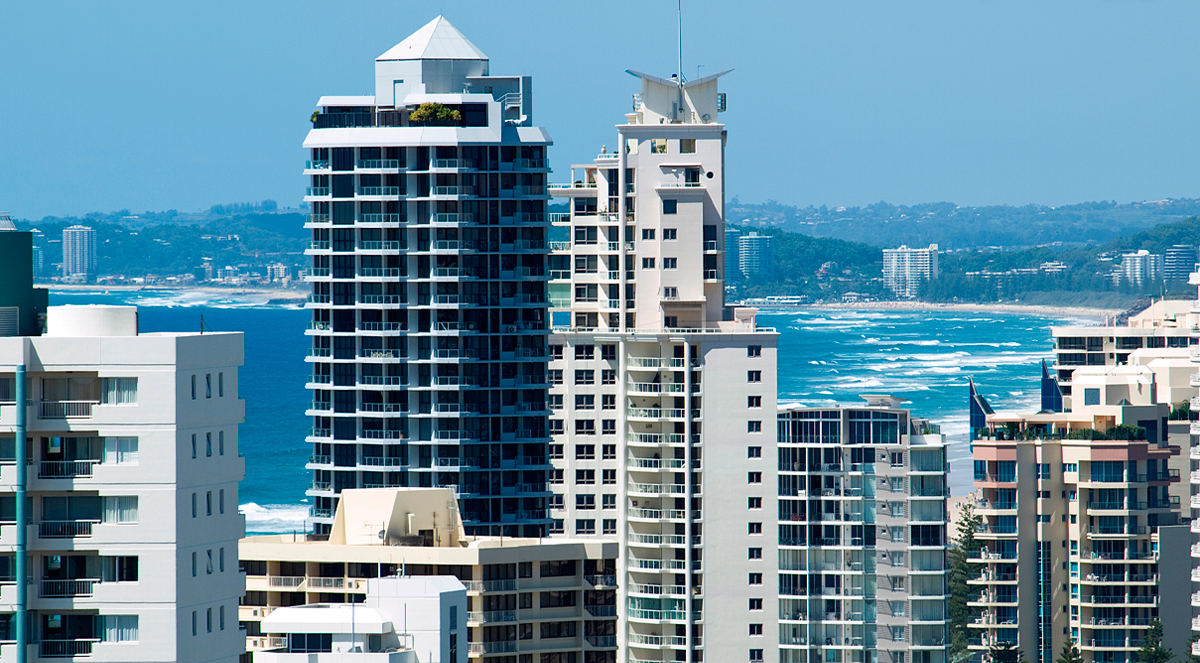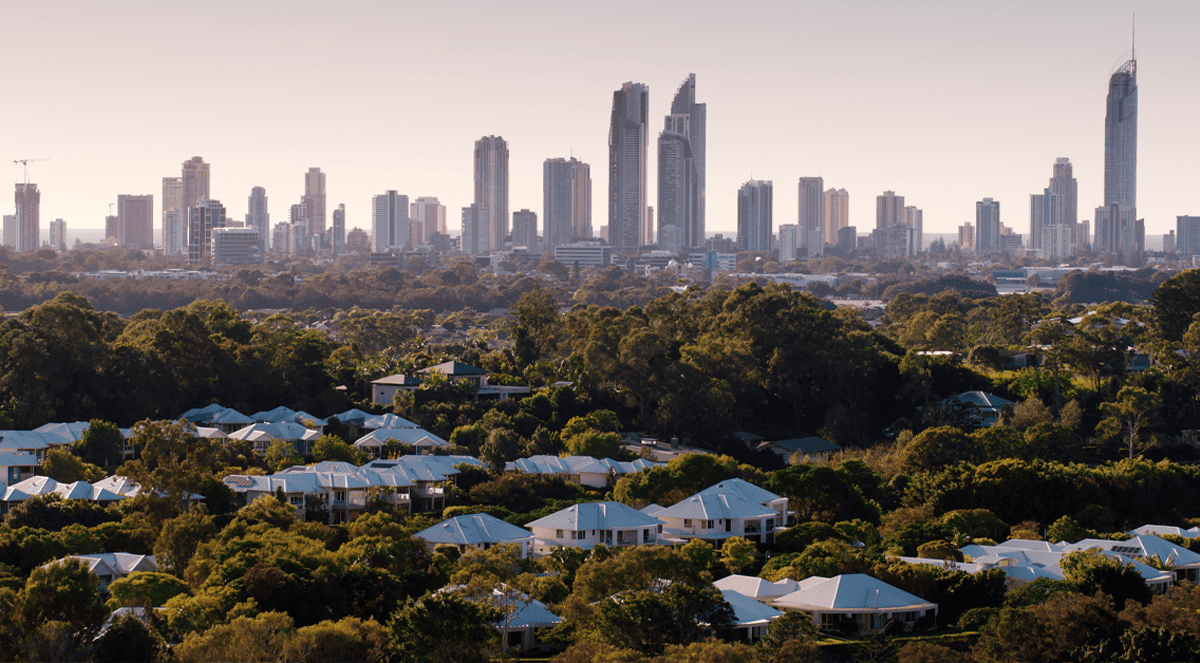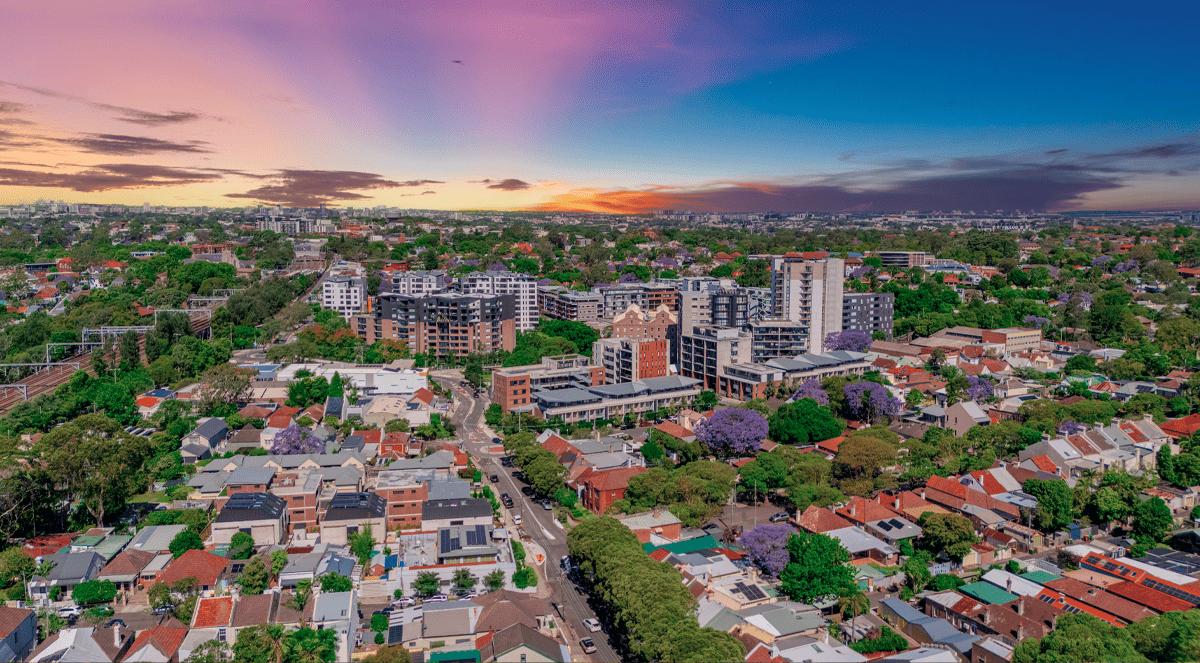Features > Property News & Insights > Market updates
Gold Coast sets new national apartment benchmark

KEY POINTS
- The Gold Coast’s median unit price has climbed to $956,000, surpassing Sydney’s and marking the first time the QLD city has led Australia’s urban apartment market
- Ray White says the price surge reflects booming demand in south-east Queensland, driven by migration, lower interest rates, and new housing shortage
- Prestige coastal suburbs such as Main Beach, Burleigh Heads, and Palm Beach have led price gains, while high construction costs and limited land are constraining new supply
The Gold Coast has achieved an extraordinary property milestone, with the median unit price in the Queensland city overtaking Sydney’s.
The development marks a seismic shift in Australia’s housing landscape.
According to new data from Ray White’s research arm, Neoval, the Gold Coast’s median unit price has climbed to $956,000, eclipsing Sydney’s at $927,000.
The details
“The Gold Coast now has a higher median unit price than Sydney — an extraordinary milestone for a market once seen as an affordable coastal alternative,” says Ray White’s Chief Economist Nerida Conisbee.
While Sydney retains its title as the nation’s most expensive city for houses, the Gold Coast’s surge in apartment values reflects booming demand across south-east Queensland, driven by population growth, lower interest rates and a severe shortage of new homes.
Neoval’s latest data also shows the Sunshine Coast, also in south-east Queensland, has just edged out Sydney for second place on median unit pricing.
Nerida Conisbee says the Gold Coast’s property market has reaccelerated after a brief mid-year pause, buoyed by three interest rate cuts that have boosted borrowing power.
“Migration continues to be a major factor,” she says.
“The region is attracting new residents from across Australia and overseas, drawn by lifestyle, climate and improving infrastructure.”
Premium properties
The Gold Coast’s transformation over the past five years has been “remarkable,” Ms Conisbee says, with luxury development along the coastline fuelling much of the growth.
Neoval data shows the suburb of Main Beach has the top median unit price in the coastal city, at $1.73 million, surging an incredible $880,000 over the past decade.
Burleigh Heads and Palm Beach are close behind, with gains of $760,000 and $740,000, respectively.
“These results underline how the Gold Coast’s prestige markets have powered its growth cycle,” Ms Conisbee says.
Suburbs including Miami, Coolangatta, Mermaid Waters and Paradise Point have all notched up increases of between $670,000 and $700,000 since 2015, evidence of broad strength across the city’s prime coastal corridor.
Demand is being led by downsizers and interstate buyers from Sydney and Melbourne seeking high-end beachfront living.
Developers have responded with a wave of resort-style apartment projects, featuring large floorspaces and premium amenities.
Investors and first-home buyers active
Investor activity has also surged, with lending in Queensland to this market segment now at record levels.
Rising rents and tight vacancy rates continue to draw investors chasing income and capital growth.
At the same time, first-home buyers are re-entering the market, aided by government grants and cheaper loans.
Many are snapping up smaller apartments once used as holiday rentals and turning them into permanent homes, a trend Ms Conisbee says is reshaping parts of the coastline.
“Areas once dominated by short-stay accommodation now have a more permanent residential feel,” she says.
“That’s adding new depth to the market while tightening the supply of holiday rentals.”
Tight supply
Despite the region’s booming population, housing supply remains critically tight.
“The last time we saw enough homes built in Australia was in 2007, and the backlog has only grown since,” Ms Conisbee notes.
“Construction timelines have lengthened, costs remain elevated, and the number of completions continues to fall.”
And Ms Conisbee warns that affordable housing is becoming increasingly hard to build in the booming coastal city.
“While construction costs are starting to moderate nationally, they remain high in Queensland, limiting the viability of lower-priced developments,” she says.
“New stock under $750,000 is now almost impossible to deliver without significant incentives or planning flexibility.”
“High construction costs, limited land availability, and stretched delivery timelines will continue to hold back new projects,” Ms Conisbee warns.
“Even with further rate relief, it’s unlikely that supply will accelerate quickly enough to ease pressure on prices in the short term.”
The outlook
For now, the Gold Coast’s median unit price leads the nation, and Ms Conisbee believes that position is unlikely to change anytime soon.
“Price growth may moderate as more projects are completed,” she says, “but without a substantial lift in new construction, the imbalance between demand and supply will remain the defining feature of the market through 2026.”
Stay Up to Date
with the Latest Australian Property News, Insights & Education.




.png?width=292&height=292&name=Copy%20Link%20(1).png)
 SIGN UP FOR FREE NEWSLETTER
SIGN UP FOR FREE NEWSLETTER





.jpg?width=1920&height=1080&name=Warning%2c%20You%20Might%20Be%20Facing%20Higher%20Taxes%20Soon%20(1).jpg)





.png?width=1920&height=1080&name=Rate%20Drops%20Signal%20BIGGEST%20Property%20Boom%20in%20DECADES%20(1).png)

.jpg?width=1920&height=1080&name=Labor%20vs%20Liberal%20These%20Housing%20Policies%20Could%20Change%20the%20Property%20Market%20Forever%20(1).jpg)
.jpg?width=1920&height=1080&name=QLD%20Slashes%20Stamp%20Duty%20Big%20News%20for%20Investors%20%26%20Home%20Buyers%20(1).jpg)
.jpg?width=1920&height=1080&name=Trump%20Just%20Slapped%20Tariffs%20%E2%80%93%20Here%E2%80%99s%20What%20It%20Means%20for%20Australia%20(1).jpg)
.jpg?width=1920&height=1080&name=Federal%20Budget%202025%20More%20Debt%2c%20No%20Housing%20%E2%80%93%20Here%E2%80%99s%20What%20You%20Need%20to%20Know%20(1).jpg)
.jpg?width=1920&height=1080&name=Australias%20Housing%20Crisis%20is%20about%20to%20get%20MUCH%20Worse%20(New%20Data%20Warns).jpg)
%20(1).jpg?width=1920&height=1080&name=Australias%20RENTAL%20CRISIS%20Hits%20ROCK%20BOTTOM!%20(2025%20Update)%20(1).jpg)
%20(1).png?width=1920&height=1080&name=Is%20Adelaide%20Still%20a%20Good%20Property%20Investment%20(2025%20UPDATE)%20(1).png)
.jpg?width=1920&height=1080&name=RBA%20Shocks%20with%20Rate%20Cuts!%20What%E2%80%99s%20Next%20for%20Property%20Investors%20(1).jpg)
%20(1).jpg?width=1920&height=1080&name=I%20Predict%20The%20Feb%20Rate%20Cut%20(My%20Price%20Growth%20Prediction)%20(1).jpg)
.png?width=1920&height=1080&name=Why%20Property%20Prices%20Will%20Rise%20in%202025%20Market%20Predictions%20(1).png)
.jpg?width=1920&height=1080&name=Why%20Investors%20Are%20Choosing%20Apartments%20Over%20Houses%202%20(1).jpg)
.jpg?width=1920&height=1080&name=Why%20Rate%20Cuts%20Will%20Trigger%20A%20Property%20Boom%20(1).jpg)
.jpg?width=1920&height=1080&name=Retire%20On%202Million%20With%20One%20Property%20(Using%20SMSF).jpg)
.jpg?width=1920&height=1080&name=4%20Reasons%20Why%20You%20Should%20Invest%20in%20Melbourne%20Now%20(1).jpg)
%20(1).jpg?width=1920&height=1080&name=Old%20Property%20vs%20New%20Property%20(Facts%20and%20Figures%20Revealed)%20(1).jpg)
%20(1).jpg?width=1920&height=1080&name=Will%20The%20New%20QLD%20Govt%20Create%20a%20Property%20Boom%20or%20Bust%20(My%20Prediction)%20(1).jpg)
%20Scott%20Kuru%20(1).jpg?width=1920&height=1080&name=Inflation%20Hits%20Three-Year%20Low%20(Will%20RBA%20Cut%20Rates%20Soon)%20Scott%20Kuru%20(1).jpg)
.jpg?width=1920&height=1080&name=How%20to%20Buy%20Investment%20Property%20Through%20SMSF_%20The%20Ultimate%20Guide%20(1).jpg)
.jpg?width=1920&height=1080&name=Victoria%20Slashes%20Stamp%20Duty%20Melbourne%20Set%20to%20Boom%20Scott%20Kuru%20(1).jpg)
.png?width=1571&height=861&name=Are%20Foreign%20Buyers%20Really%20Driving%20Up%20Australian%20Property%20Prices%20(1).png)
.jpg?width=1920&height=1080&name=The%20Single%20Factor%20That%20Predicts%20Property%20Growth%20Regions%20(1).jpg)
%20Scott%20Kuru%20(1).jpg?width=1920&height=1080&name=My%20Prediction%20On%20Rates%20%26%20Negative%20Gearing%20(Market%20Crash)%20Scott%20Kuru%20(1).jpg)

-1.png?width=1920&height=1080&name=Major%20Banks%20Cut%20Rates%20Will%20RBA%20Follow%20Suit%20(Sept%20Rate%20Update)-1.png)
%20Scott%20Kuru-1.png?width=1920&height=1080&name=Rate%20Cut%20Coming%20What%20New%20Zealands%20Move%20Means%20for%20Australia%20(Sept%20Prediction)%20Scott%20Kuru-1.png)
%20(1).jpg?width=1920&height=1080&name=Buy%20when%20the%20interest%20rates%20are%20high!%20(Why%20you%20must%20buy%20now!)%20(1).jpg)
.jpg?width=1920&height=1080&name=Carms_Revised%20Taxes%20Due%20Aug%209%20YT%20Thumbnail02%20(1).jpg)
.jpg?width=1920&height=1080&name=Carms_Too%20Little%20Too%20Late%20Aug%207%20YT%20Thumbnail01%20(1).jpg)









.jpg?width=1920&height=1080&name=Carms_Rate%20Drop%20In%20July%20Jun%2010%20YT%20Thumbnail02%20(1).jpg)
.jpg?width=1920&height=1080&name=Carms_Own%20a%20Property%20V6%20Jun%205_YT%20Thumbnail%20(1).jpg)









.png?width=1920&height=1080&name=Artboard%201%20(3).png)






.jpg?width=1920&height=1080&name=YT%20thumbnail%20%20(1).jpg)

